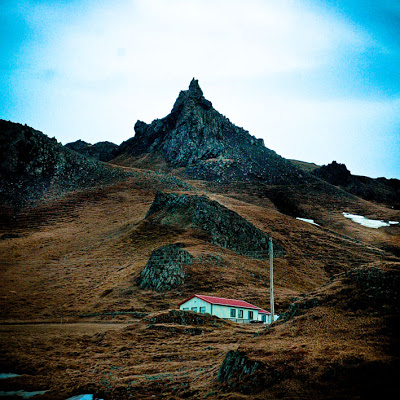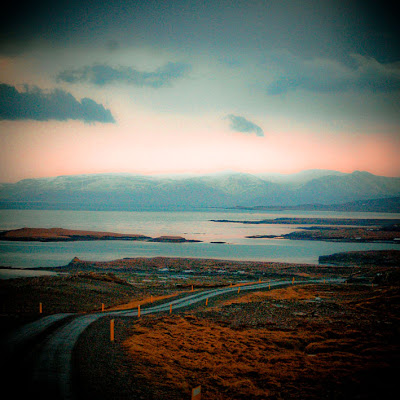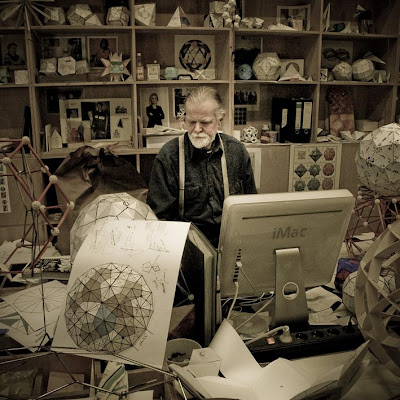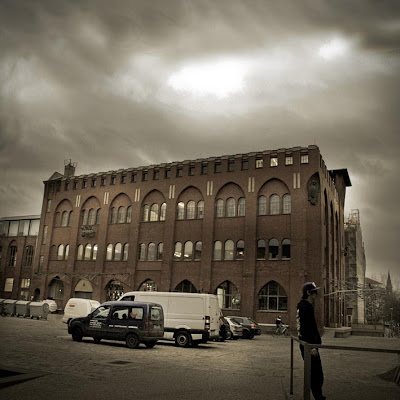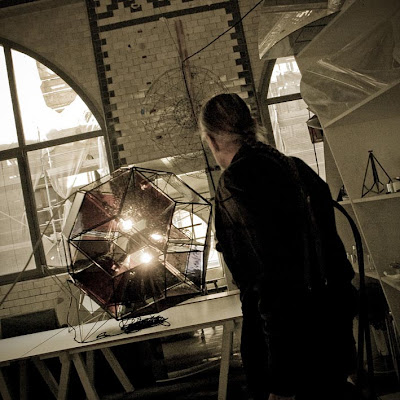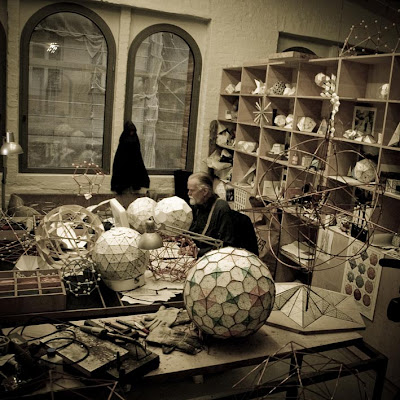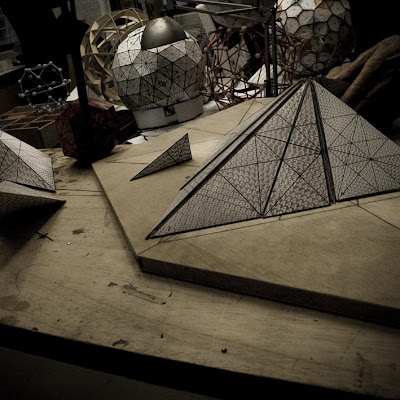2011
May 10, 2011
"Clothing is armor to survive the reality of everyday life," says Bill Cunningham in "Bill Cunningham New York," an utterly charming film. I don't intend to make repeating blog posts a habit, but under the circumstances, this one from April, 2008 seems appropriate. BTW I'm told told by a friend who worked for her that Anna Wintour (who figures prominently in the film) hated the word "blog" and insisted that everyone around her say, "weblog." I'm working on creating the situation where I never have to hear the word "enthuse" again.
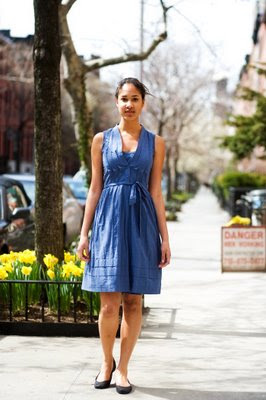

The Sartorialist, who I check in with daily, has a hard row to hoe. He takes a picture like this one, yesterday, and in the comments someone complains that the dress is "wrinkled” (hey, he’s a street photographer; people actually stand up and sit down in these clothes) and “gaps at the bust” (cutely, I think). My own brush with fashion fame came several years ago. On one of the most horrid hot humid days ever in New York, I was on Fifth Avenue with my Chinese paper parasol when a man with a camera ran up and snapped it in my face. I said, nastily, “You can’t do that” and he said, just as nastily, “I wasn’t taking a picture of you, I was taking a picture of Tiffany’s window behind you.” I got about three more blocks before realizing that he was Bill Cunningham from the Times and when I got home, wrote him a short apology, saying that I mistook him for a rude tourist from Iowa. I forgot about it completely until several Sundays later when I was meeting a friend who had with her a copy of the Times—and there I was, in a layout about parasols, snarling under mine. That week I received a print of the picture in the mail and a note from Cunningham who wrote, “It’s the tourists from Iowa who are the polite ones. I was undone by the sight of you with your parasol” –more gracious than I deserved. The picture is somewhere in the gazillion boxes that are still unpacked after my move of a year and a half ago—when I unearth it (if they still have blogs then) I'll post it.
Comments (1)
April 27, 2011
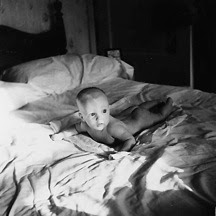 |
| PRODIGY: The artist at four months |
A Burgeoning Film Career Based on Random Encounters (New York Times, February 24, 2011).... Everything Ms. Nakadate has done during her decade-long career is discomfiting, and willfully so. Some will call her a narcissist, an opinion not dispelled by a display of 365 large color photographs of herself crying — one for every day of 2010 — in most cases stripped down to her underwear or less.
…..Rather than brush off the attention of unknown men, [Nakadate] would engage with some of the least appealing specimens: balding, overweight, badly dressed, pathetic solitaries in their 40s, 50s and 60s. In response to their advances, she would propose to go home with them if they would collaborate with her in making an art video. (more)
The Serial Sleepover Artist (New York Times, April 13, 2011) ....Ms. Robinson imagined a 13-week-long performance-art piece, and offered herself up as a guest (10 hours of housework included, but the host must supply the toothpaste) to anyone who would have her. (more)
I was planning to keep it secret for at least another few years, but after Keith Richards stole my title for his autobiography (that’s the last time I confide in him!) and I read about Laurel Nakadate and Kenya Robinson in the Times, I realized I had to reveal my project to the world. Everyone should know that I was there first.
So, yes, it’s called Life, and when completed, will be the longest performance art piece ever executed, as it started with my birth and will end when I’m eighty or ninety and choose to leave this body. I actually hit on the concept before I was born, since hanging out in the womb for nine months gave me a lot of time to think. The idea was to explore issues of gender, sexual identity, race, economic status, suburban ennui and the malleability of language in an extreme situation: the actual world. Luckily my father was a good amateur photographer, which meant that the first three years of my life were well documented in daily snapshots for which I often posed nude, topless, and sometimes crying. However I never felt that suffering was necessary for my work to be important. Rather I thought it would be even more challenging (but perhaps less acceptable to the art world, which associates grimness with significance) if I insisted on meeting each event that came my way with a cheerful attitude. I mean as long as I’m going to all this trouble, I might as well have fun.
And fun it has been, especially the part that anticipated Nakadate and Robinson’s work with strangers. Funded by odd jobs and fueled by alcohol and various well-chosen drugs, that segment of my practice took place over not months but years when, in the late seventies and early eighties, I regularly invited random people into my home or went to theirs, following late nights at Max’s Kansas City or Danceteria. Inventing what eventually became known as scatter art, I kept mementos of these encounters—single socks, not-so-white tighty whities, condom wrappers, ripped fishnet stockings and cassette tapes by the Fleshtones and the Weather Girls—stuffed into plastic garbage bags that would occasionally burst open, leaving their contents in piles on the floor.
The endurance aspect of my work has spanned decades, starting with having to sing “Old MacDonald” in nursery school, sitting next to Jimmy Earle as he picked his nose in Miss Reese’s fifth grade, and myriad temp jobs as a Kelly Girl (Marina Abramovic should try spending eight hours a day in the basement office of the Purchasing Manager at Evanston Hospital). Currently I've been focusing on phone encounters with customer service, notably the automated voice prompts utilized by Apple and Verizon, where I have made the significant discovery that yelling “fuck” loudly into the receiver gets me routed immediately to a live representative.
Although conceived of as a single performance, as I have grown and changed, so has my work. Influenced by the writings of Derrida and Foucault, my thinking has become increasingly post-structuralist so that now, not wanting to be confined to a single theme, I'm choosing to thrust myself directly into the environment where, unfettered by artificial manipulation or even expectation, I simply allow my work to unfold. This decision has its roots not only in philosophy but practicality, because if there's one thing I've learned from doing this, it's that no matter how much I plan, shit happens.
April 21, 2011
I took a little hiatus and went to Los Angeles to hang out with family, my only cultural outing being a concert by the Philharmonic at 
I didn’t realize the impression it made on me until I came home and did this drawing:
| Carol Diehl, Aiguillon, 2011, powdered pigment & pencil on paper, 11" x 14" |
However seeing the name “Disney” spelled out in lights on the side of a Gehry building did seem incongruous, as does the name of the airport I usually fly into: Bob Hope Airport in Burbank. Wouldn't naming an airport after a sober, dependable, father-of-his country type rather than a comedian inspire more confidence? Just as, if you were wanting to prime people to laugh, you wouldn't name a comedy club after a president (although the “Gerald Ford Comedy Club” kinda works.) But as long as we’re naming airports after funny people, why not Groucho Marx? Or Margaret Cho? I’d definitely pay extra to fly into Lenny Bruce Airport.
More to come....
April 12, 2011
Readers of this blog know that I'm a big fan of Iceland, as well as Icelander Guðmundur Oddur Magnússon's photographs.. Here are some images from his trip last weekend, up north to the Westfjords. This would be a wonderful time to be in Iceland, as the days grow longer, although I can also get into the January opposite, with its dense, never-ending dark. I'm into extremes, and Iceland is a land of extremes.
April 5, 2011
Even more additions to our list of art trends that should be consigned to the dustbin (see posts below):
…artists doing real world things, such as setting up a store, or a bakery, or a bar, etc., and presenting it as art. (Giovanni wrote: It's a favorite at art fairs and biennials, and IT'S DRIVING ME INSANE! And yes, Rirkrit Tiravanija fits squarely into this genre, and I don't care how much Jerry Saltz loves his cooking.)
…artists doing real world things, such as setting up a store, or a bakery, or a bar, etc., and presenting it as art. (Giovanni wrote: It's a favorite at art fairs and biennials, and IT'S DRIVING ME INSANE! And yes, Rirkrit Tiravanija fits squarely into this genre, and I don't care how much Jerry Saltz loves his cooking.)
Anything related to consumerism, especially luxury objects. (K.I.A. wrote: I don't want to see any more depictions of diamonds, chandeliers, fancy wallpapered rooms, etc.)
Incomprehensible manifestos that include references to Derrida and post-structuralism.
Those who paint their houses purple, wear a silly wild hats and call themselves “outsider artists.”
Mocking religion, Republicans, and suburban consumer culture.
Those who paint their houses purple, wear a silly wild hats and call themselves “outsider artists.”
Mocking religion, Republicans, and suburban consumer culture.
I will add: off-hand painting that makes it appear as if the artist is detached, not willing to make a whole-hearted commitment to either the subject or the process. The message, regardless of subject matter, is: “Look! I’m here in a gallery and I’m not even trying!” A friend calls it “poke-in-the-eye” art, as it seems to be jeering at those of us who are trying.
....and the prize for the artist whose work combines more outmoded trends than any other goes to Karen Kilimnik, at 303 Gallery of whom Guy Forget of Art Fag City says, “it’s safe to assume that the relatively ‘off-hand’ design of the 303 show is intentionally underwhelming.”
My point exactly.
March 30, 2011
From the comments here and on Facebook, I’ve collected additions to my list of art trends on which there should be an enforced moratorium (see the post below):
"Hey, I am a junkie, and here is my art about that"
Piles of laundry on the floor' in the middle of galleries…and these little abodes in the middle of galleries and museum rooms as some sort of installation.
Objects and/or bodily fluids in canning jars.
And for the “scatter art” category: Karen Kilimnik at 303 gallery…oh dear, do we have to wander through your pile of artfully crushed plexi mirrors, record covers and scarves while listening to a horribly skipping recording of madonna's like a virgin??!
Another reader writes: it's a challenge to go to a Brown U. or RISD exhibit these days that does not involve black curtains and headphones accompanying virtually every object. And the self-indulgent navel-gazing art ("wow, that navel lint would make a great art piece if I collected it for a year and put it on a shallow ledge in the gallery.")
I want to make it clear that I’m not against video in galleries, just cheesy, thoughtless, installations of same….although I will admit I discovered Christian Marclay in a museum in Zurich and Omer Fast at the Whitechapel, both on plain old monitors—but with no headphones or curtains, at least. Video can be cool when it takes over the whole gallery, as Marclay did with The Clock and Video Quartet, or is shown in an area that's artfully constructed, like the Alfredo Jaar at Galerie Lelong a couple of years ago.
But I never want to put on a pair of headphones again. Why would I want to be tethered to an artwork? And aren’t they’re unhygienic?
Despite the above, I was holding to my belief that everything can still be done if it's done well (except maybe for sequins) until I got this message from James Elkins on Facebook yesterday:
My latest FB "friend" is an artist who makes abstract, Fautrier-style paintings using oil mixed with the ashes of departed family members. You supply the ashes, the information, and a 40% down payment. The artist is totally sincere. That sort of thing is why FB can only be "social" and not actually social!
And why “art” is only sometimes art.
March 22, 2011
I recently received these photos from Guðmundur Oddur Magnússon, who took them while visiting Einar Thorsteinn in Olafur Eliasson’s Berlin studio. Readers of this blog will remember that Einar is an architect, mathematician, and visionary, a protégée of Buckminster Fuller, who collaborates with Olafur on his geometric constructions and the Model Room, which has been exhibited widely (see labels below). amazing photographs of the Icelandic volcanic eruption I posted at the time.

March 17, 2011
Hennessy Youngman, an Ali G. for the art world, explains Relational Aesthetics. Afterwards there will be a quiz. (Thanks to Andrew Prayzner.)

